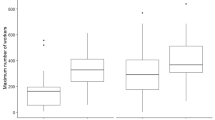Summary:
Two DNA microsatellite markers were used to assess the effective number of mating and the maternity of males in two colonies of Austroplebeia australis (Hymenoptera, Meliponini). In both colonies, the worker genotypes indicated that a single male had inseminated the queens, and the male genotypes indicated that the queens had produced the majority of the males sampled. These results are contrary to the widespread idea that workers would reproduce more readily in monandrous colonies. Possibly, alternative mechanisms such as queen policing, which hinders worker reproduction, might be evolved within this stingless bee taxon.
Similar content being viewed by others
Author information
Authors and Affiliations
Additional information
Received 6 April 1999; revised 5 April and 23 May 1999; accepted 8 June 2000.
Rights and permissions
About this article
Cite this article
Drumond, P., Oldroyd, B. & Osborne, K. Worker reproduction in Austroplebeia australis Friese (Hymenoptera, Apidae, Meliponini). Insectes soc. 47, 333–336 (2000). https://doi.org/10.1007/PL00001725
Issue Date:
DOI: https://doi.org/10.1007/PL00001725



